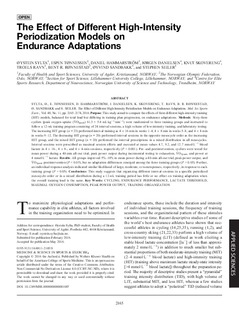| dc.contributor.author | Sylta, Øystein | |
| dc.contributor.author | Sandbakk, Øyvind | |
| dc.contributor.author | Hammarström, Daniel | |
| dc.contributor.author | Danielsen, Jørgen | |
| dc.contributor.author | Skovereng, Knut | |
| dc.contributor.author | Rønnestad, Bent | |
| dc.contributor.author | Seiler, Stephen | |
| dc.contributor.author | Tønnesen, Espen | |
| dc.date.accessioned | 2018-01-23T10:04:36Z | |
| dc.date.available | 2018-01-23T10:04:36Z | |
| dc.date.created | 2017-08-04T12:51:31Z | |
| dc.date.issued | 2017 | |
| dc.identifier.citation | Medicine & Science in Sports & Exercise. 2017, 49 (6), 1137-1146. | nb_NO |
| dc.identifier.issn | 0195-9131 | |
| dc.identifier.uri | http://hdl.handle.net/11250/2478970 | |
| dc.description.abstract | PURPOSE:
Investigate development of specific performance adaptions and hormonal responses every fourth week during a 12-wk high-intensity training (HIT) period in groups with different interval-training prescriptions.
METHODS:
Sixty-three well-trained cyclists performing a 12-wk intervention consisting of two to three HIT sessions per week in addition to ad libitum low-intensity training. Groups were matched for total training load, but increasing HIT (INC) group (n = 23) performed interval-sessions as 4 × 16 min in weeks 1-4, 4 × 8 min in weeks 5-8, and 4 × 4 min in weeks 9-12. Decreasing HIT (DEC) group (n = 20) performed interval sessions in the opposite order as INC, and mixed HIT (MIX) group (n = 20) performed all interval-sessions in a mixed distribution during 12 wk. Cycling-tests and measures of resting blood hormones were conducted pre, weeks 4, 8, and 12.
RESULTS:
INC and MIX achieved >70% of total change in workload eliciting 4 mmol·L [la] (Power4mM) and V˙O2peak during weeks 1-4, versus only 34%-38% in DEC. INC induced larger improvement versus DEC during weeks 1-4 in Power4mM (effect size, 0.7) and V˙O2peak (effect size, 0.8). All groups increased similarly in peak power output during weeks 1-4 (64%-89% of total change). All groups' pooled, total and free testosterone and free testosterone/cortisol ratio decreased by 22% ± 15%, 13% ± 23%, and 14% ± 31% (all P < 0.05), and insulin-like growth factor-1 increased by 10% ± 14% (P < 0.05) during weeks 1-4.
CONCLUSIONS:
Most of progression in Power4mM, V˙O2peak and peak power output was achieved during weeks 1-4 in INC and MIX, and accompanied by changes in resting blood hormones consistent with increased but compensable stress load. In these well-trained subjects, accumulating 2-3 h·wk performing 4 × 16 min work bouts at best effort induces greater adaptions in Power4mM and V˙O2peak than accumulating ~1 h·wk performing best effort intervals as 4 × 4 min. | nb_NO |
| dc.language.iso | eng | nb_NO |
| dc.publisher | Kluwer | nb_NO |
| dc.rights | Attribution-NonCommercial-NoDerivatives 4.0 Internasjonal | * |
| dc.rights.uri | http://creativecommons.org/licenses/by-nc-nd/4.0/deed.no | * |
| dc.title | Effects of high-intensity training on physiological and hormonal adaptions in well-trained cyclists | nb_NO |
| dc.type | Journal article | nb_NO |
| dc.type | Peer reviewed | nb_NO |
| dc.description.version | publishedVersion | nb_NO |
| dc.source.pagenumber | 1137-1146 | nb_NO |
| dc.source.volume | 49 | nb_NO |
| dc.source.journal | Medicine & Science in Sports & Exercise | nb_NO |
| dc.source.issue | 6 | nb_NO |
| dc.identifier.doi | 10.1249/MSS.0000000000001214 | |
| dc.identifier.cristin | 1484212 | |
| dc.description.localcode | nivå2 | |
| cristin.unitcode | 201,18,2,0 | |
| cristin.unitname | Institutt for folkehelse, idrett og ernæring | |
| cristin.ispublished | true | |
| cristin.fulltext | original | |
| cristin.qualitycode | 2 | |

